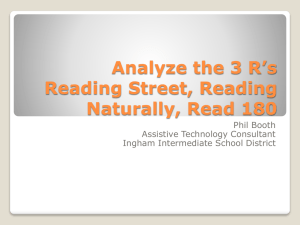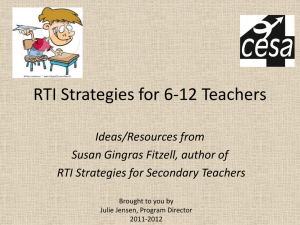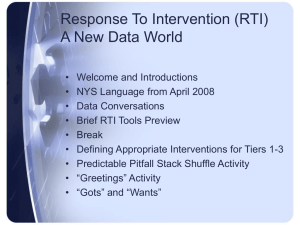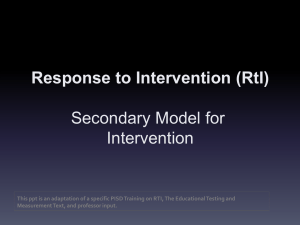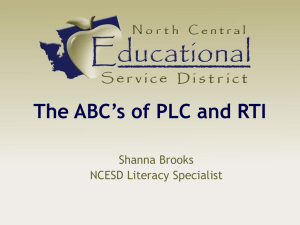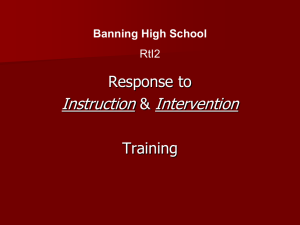What About Tier 1? by Mellie Joiner
advertisement
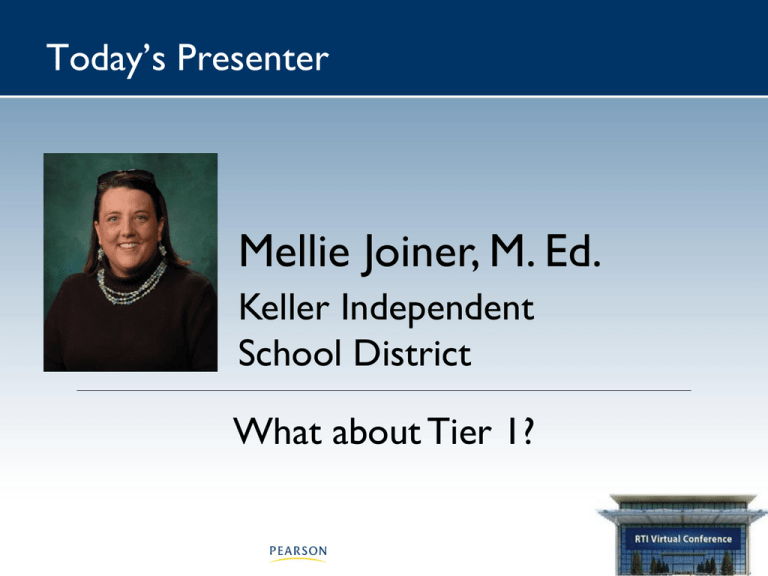
Today’s Presenter Mellie Joiner, M. Ed. Keller Independent School District What about Tier 1? What about Tier 1? Creating buy-in to improve Tier 1 Instruction for ALL students Mellie Joiner, M. Ed. 2010 RTI Virtual Conference July 26-30 Sponsored by Pearson Goals for the session • Discuss creating an atmosphere of buy-in for all staff involved in the process • Identify key characteristics of strong Tier 1 instruction 2010 RTI Virtual Conference - Sponsored by What is RtI? (Response to Intervention) • A model of support designed to improve the delivery of instruction for ALL students • A model that relies on high-quality instruction and support for student success • A model dependent upon the implementation of sound, research-based instructional practices • At Tier 1, RtI is more “Response to Instruction”… but the emphasis should be on good differentiated instruction 2010 RTI Virtual Conference - Sponsored by A Basic RtI Model The model consists of three levels or “tiers” of intervention/instruction… • Tier 1: Core classroom instruction for ALL students with informal interventions as needed • Tier 2: Strategic Intervention for students identified as struggling in Tier 1; may be provided by the general classroom teacher • Tier 3: Intensive, structured intervention in groups of no more than 3 students for students who continue to struggle even with Tier 1 AND Tier 2 support 2010 RTI Virtual Conference - Sponsored by Why RtI? “Teaching, at its core, is a moral enterprise. It is about making a difference in the lives of students– ALL students, regardless of class, gender, and ethnicity.” Michael Fullan, 1995 2010 RTI Virtual Conference - Sponsored by Which Tier should be the FIRST area of focus? TIER 1!!!! • Is instruction for ALL learners • Makes up the majority of the students’ day, even if they receive intervention support • Is the CORE of learning opportunity • Tier 1 is the foundation upon which all future learning is built 2010 RTI Virtual Conference - Sponsored by If we shore up the instruction and learning in Tier 1, we can relieve the burden on Tier 2 and 3 support so that the students who are REALLY in need of that support receive it. 2010 RTI Virtual Conference - Sponsored by What does good Tier 1 Instruction require of the administrator? • Support • Knowledge of great instructional practices, grounded in solid research • Support • Knowledge of data and how to use all data effectively • Support • Feedback • Support • Knowledge of content AND critical thinking • Reflection and Support 2010 RTI Virtual Conference - Sponsored by What actions from administrators help lead to buy-in from stakeholders? • Communicate • Dialogue • LISTEN • Get involved • Increase knowledge bases… their own and that of stakeholders • Reflect and respond 2010 RTI Virtual Conference - Sponsored by So what does Tier 1 require of the teacher? • • • • • • • Planning Data assessment Planning Instructional delivery and best practices Planning Grouping Reflection and planning 2010 RTI Virtual Conference - Sponsored by The Instructional Planning CYCLE • What gaps still exist? • What extensions are needed? • What connections still need to be made? • Informal/Formal; • Continuous/on-going 2010 RTI Virtual Conference - Sponsored by • Use all available data • What are the needs? • What is needed to meet the needs? • Strategies and techniques Adjust Plan Assess/Evaluate Implement • Collaborative implementation of the plan • Involves ALL stakeholders What should teachers consider when PLANNING for instruction? • Instructional Delivery: Includes strategies and techniques… the “how” • Instructional Materials: The “stuff” used to support instruction… the “with what” • Instructional Environment: The instructional context… the “where” • Instructional Content: The curriculum of what students need to know and do… the “what” • Instructional Assessment: Beginning and ending; informal and formal; the “how do you know” • Collaboration: The way that all of the pieces of the learning process come together; teachers and staff working together to meet student needs… the “who” Adapted from Voltz, Sims, and Nelson (2010) 2010 RTI Virtual Conference - Sponsored by What are our next steps? • Collect as much data as you can. • Analyze that data looking for all kinds of trends and patterns. • Look at what is working for ALL of your students and build on that. • Look at what is not working for more than 20% (based on data) of your students and make a plan to improve. • Repeat frequently. 2010 RTI Virtual Conference - Sponsored by Questions? Contact me: Mellie Joiner, M.Ed. melliejoiner@me.com 2010 RTI Virtual Conference - Sponsored by References and Resources • Howell, K and Nolet, V. (1999). Curriculum-Based Evaluation: Teaching and Decision Making. 3rd Edition. Wadsworth Publications. • Johnson E, Mellard D, Fuchs D, McKnight M. (2006). Responsiveness to Intervention (RTI): How to Do It. National Research Center on Learning Disabilities. • Voltz, D., Sims, M.J., Nelson, B. (2010). Connecting teachers, students, and standards: Strategies for success in diverse and inclusive classrooms. Alexandria, VA: ASCD. • Wright, J. (2007). RTI Toolkit: A Practical Guide for Schools. New York: Dude Publishing. 2010 RTI Virtual Conference - Sponsored by
